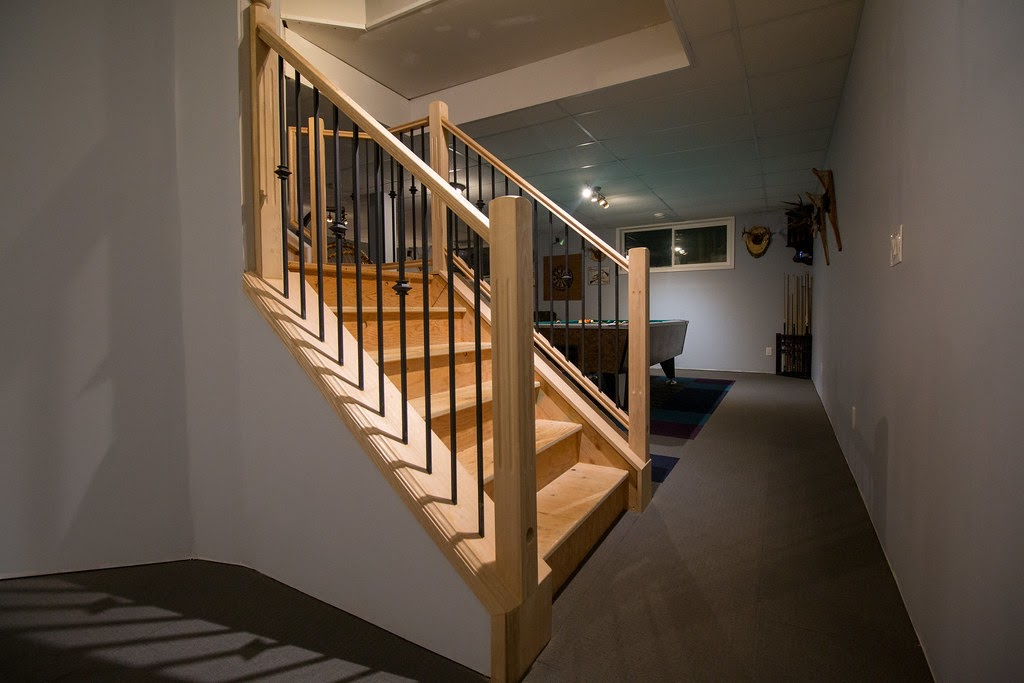Opening Hook
When Ali finally finished his basement renovation in Karachi, he envisioned cozy family movie nights with popcorn and laughter echoing across the room. But the first evening was a letdown—his brand-new TV had an awful glare from the only basement window, the console wires sprawled across the floor like vines, and the sound felt hollow. What was supposed to be a dream setup turned into frustration. His mistake? Not planning where to place the TV and consoles in his basement room before setting everything up.
Many homeowners underestimate this decision, thinking they can “just put the TV anywhere.” In reality, basement spaces are unique. Low ceilings, limited natural light, and unusual layouts make placement crucial for comfort, safety, and entertainment quality. Let’s explore how to make the most of your basement by smartly positioning your TV and consoles.
Understanding the Nature of Basement Rooms
Basements aren’t like regular living rooms. They often have fewer windows, lower ceilings, and irregular layouts. These quirks can be both a challenge and an opportunity.

For instance, limited sunlight means you don’t have to worry about constant glare from multiple windows, but a single badly placed light source can create annoying reflections on your TV screen. Likewise, the basement’s natural insulation makes it great for immersive sound systems—but only if you position the TV and speakers correctly.
As a result, the first step is to embrace the basement’s unique qualities instead of trying to set it up like a typical living room.
Read More: Survey Report & Land Measurement Before Basement Work
The Golden Rule: Eye-Level Viewing
One of the most important principles for TV placement is ensuring the screen sits at eye level when you’re seated. Watching a screen that’s too high or too low leads to neck strain and discomfort.
For example, imagine setting up your basement with a big sectional sofa and a wall-mounted TV. If you mount it too high, it may look stylish, but after two episodes of your favorite drama, your neck starts protesting. The sweet spot is usually around 42–48 inches from the floor to the center of the screen, depending on sofa height.
Furthermore, this principle applies whether you’re building a gaming den for friends or a quiet family movie retreat—comfort should come first.
Read More: Emergency Lighting Setup for Power Outage
Choosing the Right Wall
Not every wall in your basement is created equal. Some walls may back up to utility spaces or plumbing lines, making them risky for heavy mounts. Others may sit opposite windows, causing direct light to bounce onto the screen.
For instance, Fatima in Lahore decided to mount her TV opposite a small basement window. During the day, the sun poured in and washed out her screen. Curtains helped, but the better solution would have been placing the TV on a side wall, reducing glare, and preserving brightness.
In contrast, walls without windows, preferably solid concrete ones, are the safest and most stable choice for mounting heavy TVs.
Read More: Library + Workspace Layouts That Inspire
The Console Challenge: Managing Devices & Wires
If the TV is the heart of your setup, the consoles, streaming devices, and sound systems are its veins. Poorly managed wires not only look messy but can also become tripping hazards in tight basement spaces.
A good rule of thumb is to keep consoles and devices close to the TV to minimize visible cables. For instance, Ali eventually invested in a low-profile media cabinet with built-in cable management. It kept his PlayStation, soundbar, and streaming box organized while hiding the spaghetti-like mess of wires.
Furthermore, placing the cabinet against a wall with electrical outlets saves you from dragging extension cords across the floor—a common basement hazard.
Read More: Emergency Ventilation Setup for Basement Bedrooms
Creating Zones for Entertainment
Basements often serve multiple purposes: a playroom for kids, a gym corner, maybe even a small bar. To make the space functional, it helps to create zones, and your TV setup should anchor one of them.
For example, consider dividing your basement into two parts: one with dim lighting and plush seating for movie marathons, and another brighter section for board games or workouts. By placing the TV and consoles in the darker zone, you maximize immersion while leaving the rest of the room versatile.
As a result, you won’t find your treadmill blocking the view of your TV or your kids’ toys tangling with console wires.
Read More: Japanese Zen Basement Design Inspiration
Dealing with Low Ceilings and Sound
Basements often have low ceilings that affect acoustics. Sound tends to bounce off hard surfaces, making dialogue muffled or echoey. The position of your TV, console, and speakers plays a role in fixing this.
For instance, mounting a TV too close to the ceiling may force your speakers to project downward, losing clarity. Instead, keeping the TV centered at eye level allows your speakers—whether a soundbar or surround system—to distribute sound evenly.
In contrast, placing consoles and speakers inside closed cabinets can block airflow and cause overheating. Instead, opt for ventilated shelving that allows your Xbox or PlayStation to “breathe” while still looking tidy.
Read More: Homeowners’ Rights: When Municipality Rejects Your Plan
Lighting: Friend or Foe?
Lighting can make or break your basement setup. Too little light, and the space feels like a cave. Too much, and it ruins the cinematic experience.
A smart approach is to use layered lighting: overhead dimmable lights, wall sconces, and perhaps LED strips behind the TV. These reduce eye strain and add ambiance without creating glare.
For example, Ahmed in Dubai installed LED backlighting behind his wall-mounted TV. Not only did it eliminate harsh contrasts in his dim basement, but it also gave the room a sleek, theater-like vibe—all while keeping the focus on the screen.
Read More: Basement Office Ideas – 11 Stylish Work From Home Spaces
Safety First: Ventilation and Heat
One overlooked factor in basements is ventilation. Electronics like gaming consoles and amplifiers generate heat, and poorly ventilated basements can trap it.

As a result, always ensure consoles have breathing space. Don’t cram them into closed cabinets without ventilation holes, and avoid stacking devices directly on each other. A small fan or dehumidifier can also prevent overheating and protect expensive electronics from moisture damage.
Read More: Air Quality + Humidity Sensors in One Device: A Modern Essential
Real-Life Inspiration: A Basement Done Right
Let’s go back to Ali’s story. After his initial disappointment, he took a step back and rethought the setup. He moved the TV to a side wall without windows, mounted it at eye level, and added a sleek cabinet under it for his consoles. He also used cable organizers to tidy up the wiring. Finally, he installed warm LED backlighting and a comfortable sectional sofa at the perfect distance.
The result? A cozy, cinema-like basement where his family now gathers every Friday night. What once was a frustrating mistake became one of the most loved parts of his home—all because of thoughtful placement.
Read More: Mini Dance Studio for Practice Sessions
Closing: The Placement Matters More Than the Price
When setting up TVs and consoles in a basement room, it’s tempting to focus on buying the latest 4K screen or the newest gaming system. But the truth is, placement can matter just as much—if not more—than the equipment itself.
By considering factors like eye-level comfort, wall stability, lighting, ventilation, and cable management, you turn an ordinary basement into a functional, inviting entertainment hub.
So before you unbox that shiny new TV or console, pause and ask yourself: Where should this really go? Because in the end, the right placement turns a basement from a cold storage space into the warm heart of your home.
🏗️ Basement Project Calculator
Latest Post
-
Basement Ceiling Ideas Hide Ductwork Smartly
Opening Hook Imagine walking into your basement in Boise, Idaho—where the ceiling is so low that you brush your head on the joists—and noticing a sleek, well-designed backdrop above you instead of exposed ductwork and pipes. That difference, thanks to smart basement ceiling ideas, transforms a cramped, unfinished area into a welcoming space for movie…
-
أفكار رائعة لأرضيات رخيصة في دبي | أفضل ٢٠ خيارًا
تخيل زوجين شابين في شقة مريحة في مرسى دبي، يخطوان حافيي القدمين على أرضية أنيقة بلمسة خشبية. غرفة المعيشة تتلألأ بضوء مسائي خافت، والأرضية تحتها لا تزال تبدو جديدة تمامًا رغم سنوات من الاستخدام – وكل هذا بميزانية محدودة. هذه هي قوة اختيار أرضيات جميلة ورخيصة في دبي: الأناقة والتوفير في آن واحد. التركيز على…
-
Beautiful Cheap Flooring Ideas in Dubai | Top 20 Picks
Imagine a young couple in a cosy apartment in Dubai Marina, stepping barefoot onto a sleek, wood-look floor. The living room glows with soft evening light, the flooring beneath still looks brand-new despite years of use—and all this on a budget. That’s the power of choosing beautiful, cheap flooring in Dubai: style and savings in…



